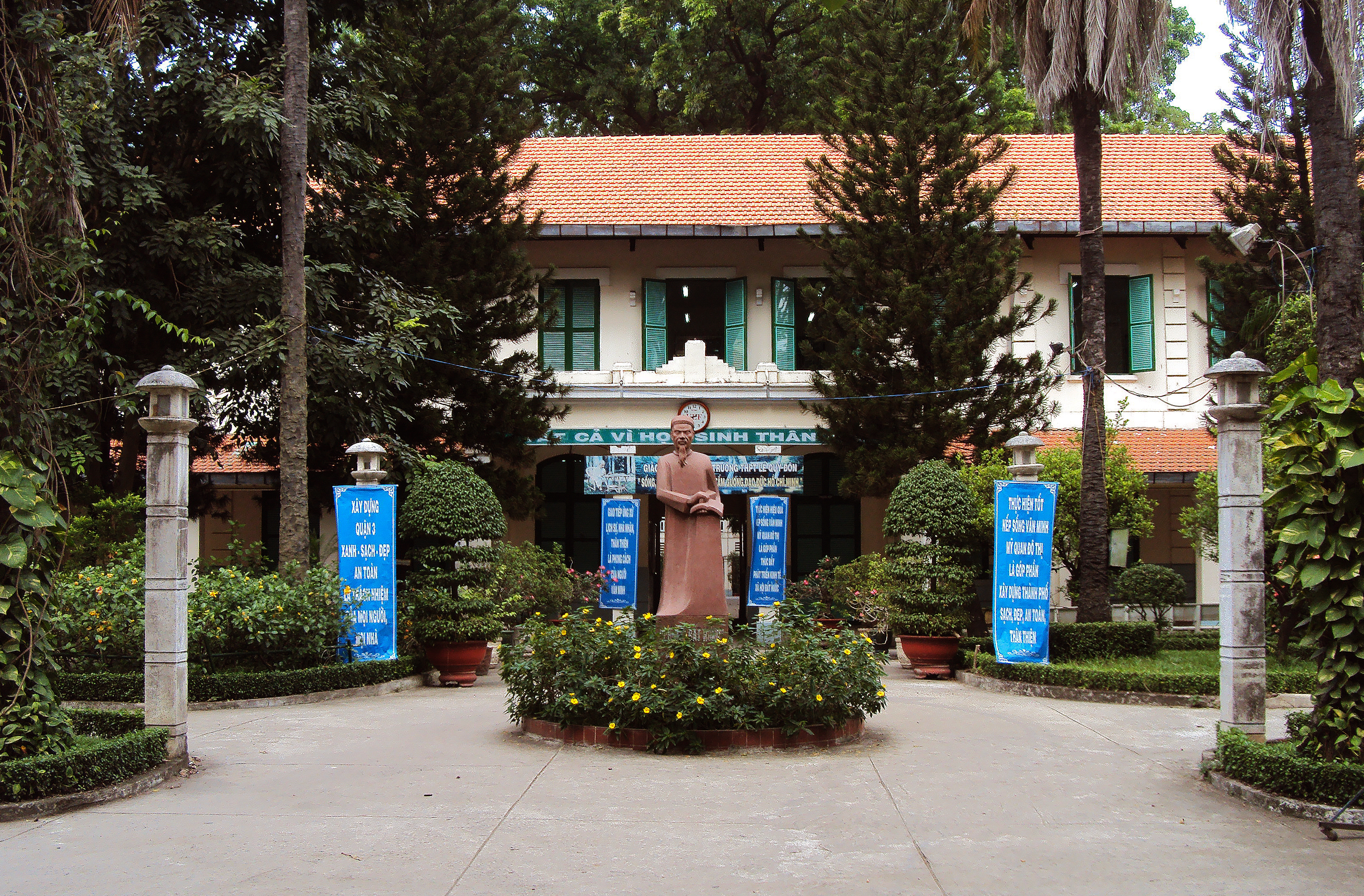
The main entrance of the Lê Quý Đôn Secondary School today
This article was published previously in Saigoneer http://saigoneer.com
The Lê Quý Đôn High School (Trường Trung học Phổ thông Lê Quý Đôn) at 110 Nguyễn Thị Minh Khai street is the city’s oldest surviving educational establishment.
The origins of the Lê Quý Đôn High School may be traced back to the École normale indigène, established by a decree of 10 July 1871, but the first school to be established on the current site was the Collège indigène de Saïgon, founded in place of the École normale by a decree of 14 November 1874.
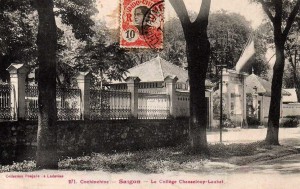
The Collège Chasseloup-Laubat in the early 20th century
Work began immediately on the construction of the school campus near the junction of rue Chasseloup-Laubat (Nguyễn Thị Minh Khai) and rue de l’Impératrice (Nam Kỳ Khởi Nghĩa), and during the two-year construction period, the school was accommodated temporarily “in the Pagode Barbé and its dependencies,” which once stood on the site of the War Remnants Museum – see my previous article Mapping the French “Line of Pagodas.”
Led by its founder Director Honoré Wattebled and a staff of European and Vietnamese teachers, the school initially offered a three-year programme for “young Annamites from good families,” the aim being “to provide interpreters and clerks for government offices, machinists for the Roads and Bridges Department, and employees for the Cadastre and Telegraph Office.”
Those students who graduated with distinction could be eligible for a generous overseas study scholarship, and accordingly, “every year, a number of the smartest young Annamites were sent to Marseille at the expense of the colony, in order to complete their studies.”
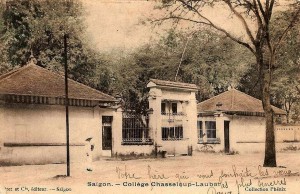
Another early 20th century view of the Collège Chasseloup-Laubat
In 1877, the Collège Indigène was named, like the street on which it stood, after the French general and military engineer François, Marquis de Chasseloup-Laubat (1754-1833). By 1879 the Collège Chasseloup-Laubat had 83 students.
Following the closure of the La Salle Christian Brothers’ Collège d’Adran in 1879, the Collège Chasseloup-Laubat was transformed into a secondary school of similar status to the Collège de Mytho. The first French children were admitted in 1880. Soon after this, the buildings were upgraded so that European and local pupils could be segregated in two distinct areas – a “Quartier Européen” for French children and a “Quartier Indigène” for local children, separated by “kitchens, courtyards, covered walkways, washrooms and pools.”
The current school buildings date from this period and feature a design typical of late 19th century French lycée architecture, with little attempt at adaptation to the tropical climate other than the peripheric gallery on the ground floor and the overhanging roofs.
In subsequent years, the number of pupils grew steadily in size, increasing from 180 in 1884 to 200 in 1903 and 290 by 1924. However, by the early 1920s there were still less than 50 European students at the Collège, since “the secondary syllabus it offered was incomplete and young French and Annamites had to travel to Tonkin to complete their secondary studies and take the baccalauréat.”
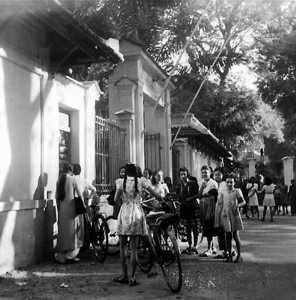
Children gather outside the Lycée Chasseloup Laubat in the 1940s
The absence of a “proper education for European children” in Cochinchina was remarked upon as early as 1903 by Governor General Paul Beau (October 1902-February 1908). “This question deserves our solicitude,” he said, “because it concerns the future of our colonisation.” However, not until 1924 was the teaching syllabus of the Collège Chasseloup-Laubat upgraded to permit the baccalauréat exams to be taken in Saigon.
In that year, the school also began admitting gifted 9-12 year-old French and Vietnamese children by entrance examination to a course of pre-secondary studies at the Collège.
Young educated Vietnamese took an active role in the anti-colonial protests of 1926 and the Collège Chasseloup-Laubat in particular became something of a hotbed of activity. Things came to a head on 4 April 1926, the day of patriot Phan Châu Trinh’s funeral, when students of the Collège wrote ABLF (À Bas Les Français– down with the French) on blackboards and participated in what subsequently became a nationwide school boycott.
“It is unfortunate that our brilliant Franco-indigenous educational secondary institutions have suffered a serious blow,” commented the newspaper L’Eveil économique de l’Indochine solemnly later that year. “School indiscipline, a basic form of social indiscipline, is completely intolerable.”
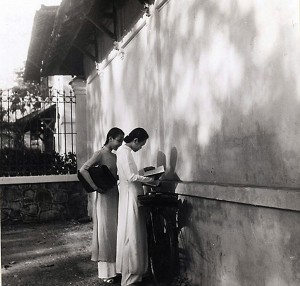
Two Vietnamese teachers pictured outside the Lycée Chasseloup Laubat in 1947
In 1927, the Collège Chasseloup-Laubat was formally upgraded to become a full secondary school named the Lycée Chasseloup-Laubat. In November of that year, over 200 local pupils were relocated to the new Collège de Cho-Quan, which was initially established as an annex of the Lycée Chasseloup-Laubat. However, in August 1928 the Collège de Cho-Quan became a secondary school in its own right, named the Lycée Petrus Ký. The first intake of new students at Saigon’s two new Lycées took place in September 1928.
During the later colonial period, the Lycée Chasseloup-Laubat became known as one of the most prestigious in the region and trained many famous individuals, including Vietnamese revolutionary leader Trần Văn Giàu (1911-2010), French novelist Marguerite Duras (1914-1996), last South Vietnamese president General Dương Văn Minh (1916-2001), King Norodom Sihanouk of Cambodia (1922-2012) and historian Vương Hồng Sển (1926-1996).
During the Japanese occupation, the school served briefly as a centre for refugees.
After the departure of the French, the school continued to operate under French management, but in 1958 its name was changed to Lycée Jean-Jacques Rousseau. Thereafter, the student intake was overwhelmingly Vietnamese.
In 1970, the school was transferred to the South Vietnamese Education Ministry and became the Lê Quý Đôn Education Centre (Trung tâm giáo dục Lê Quý Đôn), named in honour of 18th-century Vietnamese mandarin, philosopher and poet Lê Quý Đôn (1726-1784).
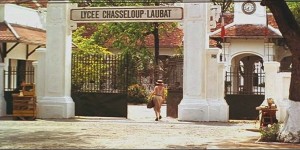
The former Lycée Pétrus Ký (now the Lê Hồng Phong Specialist Secondary School) at 235 Nguyễn Văn Cừ in District 5 stood in for the former Lycée Chasseloup-Laubat in French filmmaker Jean-Jacques Annaud’s 1992 film version of Marguerite Duras’ The Lover
Known since 1975 as the Lê Quý Đôn High School, the school remains today one of the city’s principal scholarly establishments.
The former Lycée Chasseloup-Laubat was featured in French filmmaker Jean-Jacques Annaud’s 1992 film version of Marguerite Duras’ The Lover. However, if you watch the film closely, you will see that the school used as a location is in fact not the Lycée Chasseloup-Laubat at all, but the former Lycée Pétrus Ký (now the Lê Hồng Phong Specialist High School) at 235 Nguyễn Văn Cừ in District 5!
Tim Doling is the author of the guidebook Exploring Saigon-Chợ Lớn – Vanishing heritage of Hồ Chí Minh City (Nhà Xuất Bản Thế Giới, Hà Nội, 2019)
A full index of all Tim’s blog articles since November 2013 is now available here.
Join the Facebook group pages Saigon-Chợ Lớn Then & Now to see historic photographs juxtaposed with new ones taken in the same locations, and Đài Quan sát Di sản Sài Gòn – Saigon Heritage Observatory for up-to-date information on conservation issues in Saigon and Chợ Lớn.

